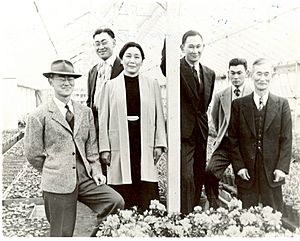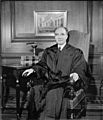Korematsu v. United States facts for kids
Quick facts for kids Korematsu v. United States |
|
|---|---|

|
|
| Argued October 11–12, 1944 Decided December 18, 1944 |
|
| Full case name | Fred Korematsu vs. United States |
| Citations | 323 U.S. 214 (more)
65 S. Ct. 193; 89 L. Ed. 194; 1944 U.S. LEXIS 1341
|
| Prior history | Certiorari to the Circuit Court of Appeals for the Ninth Circuit |
| Holding | |
| The exclusion order leading to Japanese American Internment was constitutional. | |
| Court membership | |
| Case opinions | |
| Majority | Black, joined by Stone, Reed, Douglas, Rutledge, Frankfurter |
| Concurrence | Frankfurter |
| Dissent | Roberts |
| Dissent | Murphy |
| Dissent | Jackson |
| Laws applied | |
| Executive Order 9066; U.S. Const. amend. V | |
Korematsu v. United States was a very important case heard by the U.S. Supreme Court. It was about whether the government could force Japanese Americans into special camps during World War II. This happened even if they were U.S. citizens.
In February 1942, President Franklin D. Roosevelt issued something called Executive Order No. 9066. This order gave military leaders the power to move anyone they thought might be a threat to national security. These people were moved from the West Coast of the United States to "relocation centers," which were like camps.
Contents
What Was Korematsu v. United States?
Fred Korematsu was a Japanese-American man born in the United States. He refused to follow the order to move to a camp. He was arrested and given five years of probation. He tried to fight his conviction in court. His case eventually went all the way to the U.S. Supreme Court.
The Court's Decision
The main question for the Supreme Court was this: Did the President and Congress go too far? Did they violate the rights of Japanese Americans?
In a 6-3 decision, the Court said that the need to protect the country from espionage (spying) was more important than Mr. Korematsu's rights. Justice Hugo Black wrote the main opinion for the Court. He said that the case was not about unfair treatment because of someone's family background. It was also not about whether Fred Korematsu was loyal to the U.S. Instead, it was only about his refusal to follow a legal order during wartime. So, the Court decided that the order to move people was constitutional.
What Happened After the Decision?
The Supreme Court's decision in Korematsu v. United States has been very controversial. Many people disagreed with it.
Years later, in 1983, Fred Korematsu's conviction for not going to the camp was overturned. This means the court decided he was wrongly convicted. In 1998, President Bill Clinton gave Fred Korematsu the Presidential Medal of Freedom. This is one of the highest awards a civilian can receive in the United States.
Images for kids









